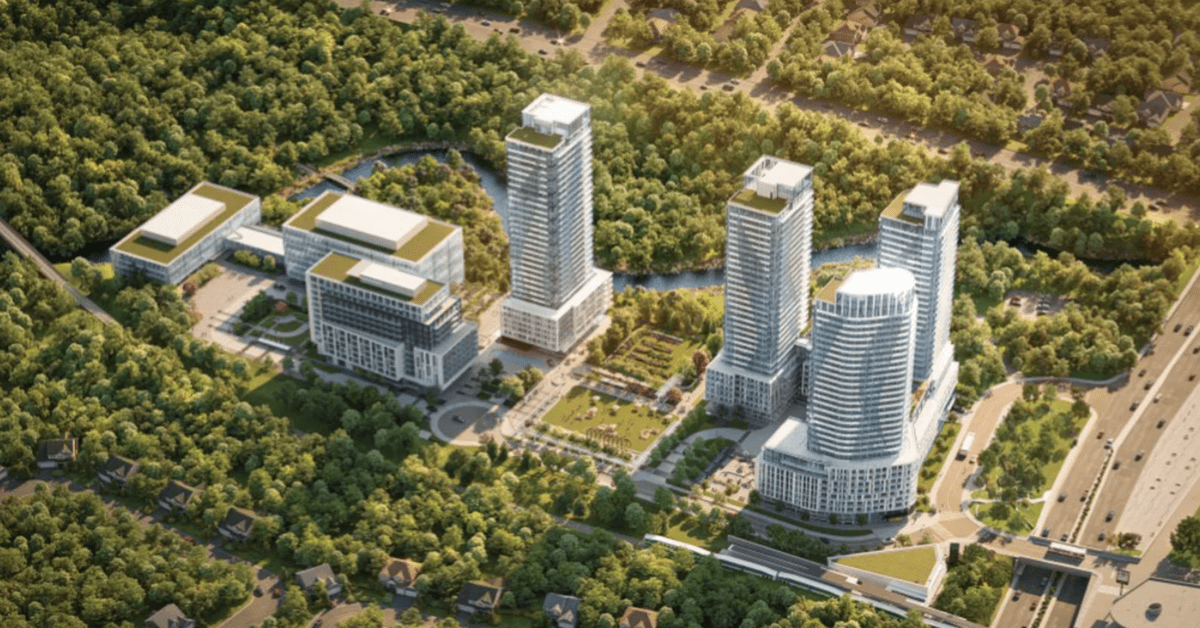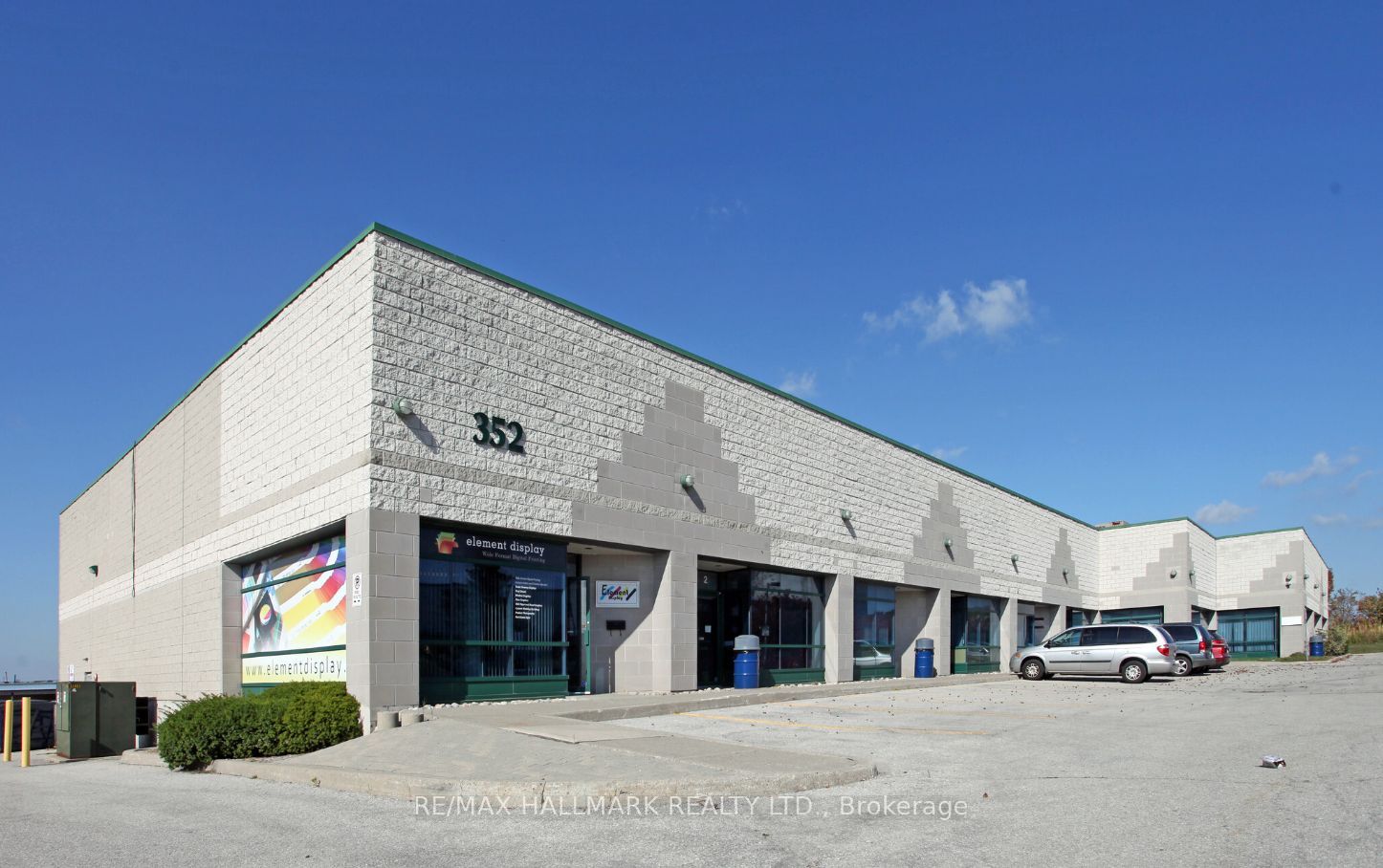Live-Work Park Community Reimagines A Legacy Office Complex

Live-Work Park Community Reimagines A Legacy Office Complex
Despite becoming one of the most transportation-connected locations in Toronto, the northwest corner of Sheppard Avenue and Leslie Street has been an underutilized commercial zone of empty lots and aging commercial buildings. That’s about to change in grand style with the development of Central Park, a live-work community just north of the Leslie station on the Sheppard subway line.
The 12-acre site that skirts the East Don Parkland will be redeveloped with five new residential towers. Two existing office buildings on the site will become key components of the new community as they’re upgraded and reclad with energy-saving glass and steel fins that create a visual effect that resembles movement when viewed from different angles.
The forested setting on a protected ravine and convenience as a transportation hub inspired the concept of a master-planned live-work community, says Jason Shiff, sales manager for Amexon Development Corp., which is breaking ground on the project this spring for occupancy in 2025.
The pair of 30-year-old buildings are rectilinear and dated but still solid, so it’s much more sustainable to upgrade them rather than tear them down and put the material into landfill.— Deni Poletti, partner of CORE Architects Inc.
The complex will have direct connections to the Leslie subway station and a relocated Oriole station on the Richmond Hill GO line, that provides non-stop service to Union Station. By car, it’s 500 metres to the Leslie Street interchange with Highway 401 and three kilometres to the Sheppard interchange with Highway 404/Don Valley Parkway.
According to Mark Fieder, president of Avison Young Canada, the project is part of an intensification trend that’s seeing large-scale residential developments incorporate legacy commercial buildings to create live-work districts.
“In many cases, it’s economically viable to retain a structure that’s in good condition and fits existing plans,” Mr. Fieder explains. “In other cases, a building may be designated historical; or if the planned community is large in scale, a phased approach may see some office and commercial buildings continue to bring in revenue during redevelopment. As the community takes shape, those commercial spaces may become more attractive, and the developer may revisit the plan to replace them.”
At Central Park, “the pair of 30-year-old buildings are rectilinear and dated but still solid, so it’s much more sustainable to upgrade them rather than tear them down and put the material into landfill,” says Deni Poletti, partner of CORE Architects Inc., which is designing the buildings at Central Park that will feature interiors by II By IV Design.
Upgrading office façades while tenants still occupy the space is becoming more common throughout Canada to improve energy efficiency, Mr. Poletti says. CORE recently designed the recladding of an office tower at Dundas Street and University Avenue while office tenants continued to work inside. The project added floors of condominiums on top to create the 55-storey Residences at 488 University.

Central Park in Sheppard-Leslie development will feature cafes. retail and markets.
All commercial buildings can lend themselves to such extensive upgrades while still in use, Mr. Poletti says; it just takes co-ordination and working with the tenants to make sure vibration is kept to a minimum as well as scheduling most of the work outside of office hours.
“Typically, what happens to protect the users inside, we put up hoarding around the perimeter with sufficient space for workers to access the skin and do the proper detailing and tying in of membranes,” he explains. “Depending on the type of work that has to be done, there may be situations where tenants have to move temporarily. At 488 University, that was not the case, but some cases may require areas be cleared for staging mechanical or electrical equipment.”
Renovating the Central Park office buildings will be a significant project. The four- and eight-storey buildings, which are connected by a two-storey link, total 325,000 square feet of space and have multiple tenants. Services in the commercial buildings include a privately operated daycare and an outdoor playground.
The concept for the reclad exteriors was envisioned to compliment the forested landscape of the Don River ravine, Mr. Poletti says. “We’re creating an optical illusion, with subtle waves in the skin of the building, and depending on where you stand, the look constantly changes. The idea is to transform these rectilinear objects into something more organic and interesting.”
The curving fins that create the fluidity will be made of enamelled steel. “We’re looking at something finished with a white enamel that has a reflective quality to add more pronunciation to the waves.”
All the glass is going to be replaced with more energy-efficient full-height windows, providing more light into the offices than does the current glazing, which is substandard by today’s norms, he says.
The next-generation mechanical systems to be added provide enhanced air flow and HEPA filtration systems and intelligent LED lighting systems and solar panels. The buildings will get energy-saving green roofs that will also enhance the view from the residences, Mr. Poletti adds.
Adding to the amenities for both residents and office tenants, the entire site will connect to the recreational trail in the Don River ravine and the Central Park, which gives the community its name, that includes a landscaped three-acre common, surrounded by cafés, bistros and a central market. Parking will be underground, with 2,000 spaces in a garage that extends beneath the entire site, and each will have a plug for electric vehicle charging, he adds.
The newly built glass-clad presentation centre on the west side of Old Leslie Street will remain a private events space and restaurant. A rooftop between two of the towers will contain part of the 55,000-square-foot Park Club for residents and guests, which includes a health club and saltwater pool.
It’s been a long process to finally break ground on the site Amexon originally acquired in 1995 and received zoning for in 2013, Mr. Shiff says. A small commercial building on the site that will become the residential zone was demolished 10 years ago and the office tenants were relocated to the other Amexon properties, and a rezoning process began.
“The development will transform the underutilized site from single-purpose daytime office use to a vibrant round-the-clock use within a community where people can live, work and play,” he says.
Source The Globe And Mail. Click here to read a full story









